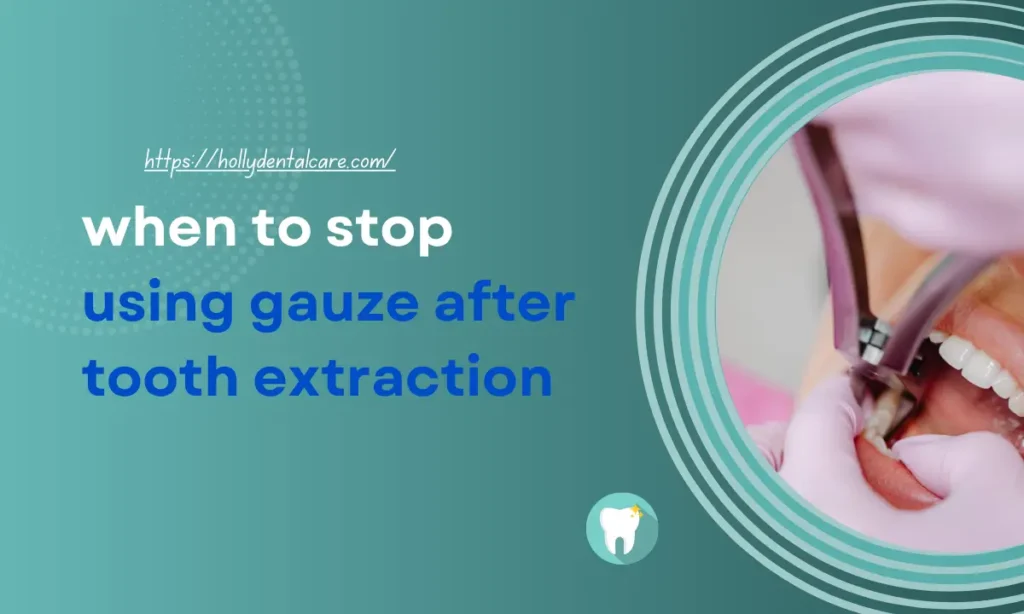The most common reasons for tooth extractions are advanced decay or gum disease in the teeth, trauma, or possibly wisdom teeth that are impacted. In general, the actual procedure is a fast and painless one, requiring only local anesthesia. Healing takes place much later; one of the first and most crucial steps for recovery is the control of the bleeding during the first hours after the extraction with sterile gauze.
In gauze, the clot formation, which is very important in wound healing and prevention of complications such as dry socket, can take place. Knowing when to stop using gauze can be as important as knowing how to use it. Keeping gauze in place longer than necessary is another possible issue; too much pressure or improper gauze use can interfere with healing, cause bleeding, and even lead to infection. In this article, we will learn about When to Stop Using Gauze After Tooth Extraction in detail.
Why Is Gauze Used After Tooth Extraction?
Blood clotting inside the resultant cavity after a tooth has fallen is important to protect the underlying nerve and bone from injury. This clot acts like a biological barrier against infection and facilitates the formation of new tissue.
Because of this, sterile gauze is laid in the socket, and patients are instructed to bite firmly on this. The gauze is going to give steady pressure, soak in extra blood and saliva, control bleeding, and keep the area clean.
How Long Should You Use Gauze After a Tooth Extraction?
First 60 Minutes: Initial Gauze Compression
- You need to bite the gauze firmly in place right after the procedure; hold it for a time span of thirty to sixty minutes.
- This is when the first clot is being formed.
- Do not talk, chew, or move the tongue, or you will displace the forming clot.
After the First Hour of Reevaluation
- After an hour, the gauze should be taken out, and there should be an examination of the site of the surgery.
- Just ooze or does not ooze at all; you may stop using gauze.
- If, however, bleeding is still going on, then a fresh gauze should be taken, damp with water, and the gauze should be applied again for 30-45 minutes.
Total Duration of Gauze Use: Usually 2-3 Hours
- Most of the bleeding stops in 2-3 hours.
- There are also cases where it is quite tough (especially for wisdom teeth surgery) and where gauze applied may take up to 4 hours, but only if the bleeding is still continuous.
Do not wear gauze at night or while asleep. This is to avoid choking and is generally not required after bleeding has stopped.
When Should You Stop Using Gauze?
Bleeding Has Stopped or Greatly Reduced
- When the gauze comes out with only light red or pink spotting, it means active bleeding has ceased.
- You’re no longer tasting blood in your mouth or seeing pooling blood on your tongue.
Clot Is Formed
- In the socket, a visible dark red clot may be seen.
- The area is dry or slightly firm and shows no signs of active bleeding or discomfort.
No Further Compression Needed
- If bleeding has slowed or stopped, do not compress the socket anymore.
- Any further pressure at this stage could dislodge this clot.
If Bleeding Persists Beyond 4 Hours
You should contact your dentist or oral surgeon if:
- Bleeding continues past 4 hours despite multiple gauze changes
- There is bright red blood soaking the gauze repeatedly
- You feel lightheaded or weak
- You have a bleeding disorder, or are taking blood thinners like warfarin or aspirin
In such cases, your dentist may apply a hemostatic agent, provide sutures, or evaluate underlying issues.
What to Do After You Stop Using Gauze
For instance, the time period that follows immediately after gauze has been applied and the bleeding is controlled will be for the protection of a blood clot and stimulation of healing. The most important things done toward recovery in an hour or two after gauze removal include:
- For the first 24 hours after gauze removal, do not rinse, spit, or drink through a straw.
- Don’t smoke or vape during the initial healing period.
- Do not poke or touch the area you had extracted with your fingers or tongue.
- Moreover, avoid disturbing the blood clot at the extraction site
- For the first 48 to 72 hours, you should reportedly eat soft, cool foods.
- Further, avoid hard, crunchy, sticky, or spicy foods that may irritate the area and delay healing.
- Furthermore, brush your other teeth as usual. However, do not brush near the extraction site for at least the first 24 hours.
Conclusion
The right usage of gauze will also, in itself, be an earlier support to the healing process following tooth extraction; however, it is also important to know when to stop. It is generally said that gauze application is required after extraction for only 2-3 hours after the surgery. Thus, better to discontinue the use of gauzes as soon as the bleeding cools or stops or clots so as not to disturb the wound. However, you should never forget not overdoing with gauze and changing it frequently.
Also read:- How to Tighten a Loose Tooth at Home: Natural Remedies & Practical Advice



